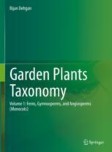Search
Search Results
-
Stilbenes: a journey from folklore to pharmaceutical innovation
In modern times, medicine is predominantly based on evidence-based practices, whereas in ancient times, indigenous people relied on plant-based...

-
Molecular phylogenetic analyses reveal a deep dichotomy in the conifer-inhabiting genus Trisetacus (Eriophyoidea: Nalepellidae), with the two lineages differing in their female genital morphology and host associations
We analyzed the phylogenetic relationships of the genus Trisetacus using two genes [cytochrome c oxidase subunit I (COI) and D1-D2 region of 28S rDNA...

-
Evaluation of antifungal activities of woody plant barks using an incubation system with Trametes versicolor
Key messageThe novel incubation system where antifungal activities of bark tissues against Trametes versicolor were evaluated revealed that the...

-
Gymnosperms
They are a morphologically and geographically diverse assemblage of ancient cone-bearing woody seed plants of considerable ornamental and economic...
-
Model Species to Investigate the Origin of Flowers
The angiosperms, or flowering plants, arose at least 135 million years ago (Ma) and rapidly diversified to form over 300,000 species alive today....
-
Anthropogenic deforestation and climate dryness as drivers of demographic decline and genetic erosion in the southernmost European fir forests
A better understanding of long-term effects of climate and historical anthropogenic changes is needed to define effective conservation measures of...

-
An Overview of the Middle Miocene to Early Pleistocene Flora of the Siwalik Sediments in Nepal
Floral taxa from the middle Miocene to the early Pleistocene have been thoroughly documented in the Siwalik sediments in the Nepal Himalayas and are...
-
Ethnobotanical Science in the Clouds: Useful Plants of Northeastern Oaxaca, Mexico
Oaxaca is one of the five Mexican states with the highest biological richness and one of the most diverse in ethnic composition. Knowledge and use of...
-
Storage Proteins and Peroxidase Activity During Zygotic and Somatic Embryogenesis of Firs (Abies sp.)
Somatic embryogenesis was initiated from immature embryos of Abies concolor (Gord. et Glend), A. numidica De Lann. and A. cilicica Carr., A....
-
Exploring the co-operativity of secretory structures for defense and pollination in flowering plants
Main conclusionIn flowers multiple secretory systems cooperate to deliver specialized metabolites to support specific roles in defence and...

-
Gymnosperms from the Early Cretaceous Crato Flora: Competitors for the Nascent Flowering Plants
The Lower Cretaceous (likely upper Barremian to lower Aptian) flora of the Crato Formation in the Araripe Basin in NE Brazil opens a unique window to...
-
Nitrogen cycling-related functional genes exhibit higher sensibility in soil than leaf phyllosphere of different tree species in the subtropical forests
AimsForest ecosystems provide a large area inhabited by functional microbial communities and thus have an important influence on nitrogen (N) cycling...

-
Arbuscular Mycorrhizal Fungi: Biodiversity, Interaction with Plants, and Potential Applications
Arbuscular mycorrhizal (AM) fungi are root symbiont found in association with plants under various geoclimatic and edaphic conditions. Biodiversity...
-
Soil spore bank communities of ectomycorrhizal fungi in Pseudotsuga japonica forests and neighboring plantations
Ectomycorrhizal (EcM) fungal spores play an important role in seedling establishment and forest regeneration, especially in areas where compatible...

-
Landscape genetics reveals that adaptive genetic divergence in Pinus bungeana (Pinaceae) is driven by environmental variables relating to ecological habitats
BackgroundUnderstanding the genetic basis of local adaptation has long been the concern of biologists. Identifying these adaptive genetic...

-
Gymnosperms of Nepal: Diversity, Distribution, Economic Importance, and Future Perspectives
Nepal has a total of 29 taxa of wild gymnosperms from 26 species, seven families, and 11 genera. Juniperus L. is the largest genera with six taxa,...
-
Key to the Groups of Families of Trees and Shrubs
This chapter includes keys and is dedicated to trees and, to some extent, lianas. It represents the first step of the identification process. It...
-
Root carboxylate release is common in phosphorus-limited forest ecosystems in China: using leaf manganese concentration as a proxy
Background and aimsCertain plant species release root carboxylates in response to phosphorus (P) limitation; however, the prevalence of root exudate...

-
Utilization of essential oils mainly from Cupressaceae trees in the work environment creates a psychophysiological stress-relieving effect
The benefits of short-term inhalation of conifer aromas are well known, and their effects on the human body and mind in indoor work environments were...

-
Interspecific variation in the timing and magnitude of hydraulic redistribution in a forest with distinct water sources
AimsTrees regulate water availability among their rooting strata through a nocturnal, passive transference of water known as hydraulic redistribution...

